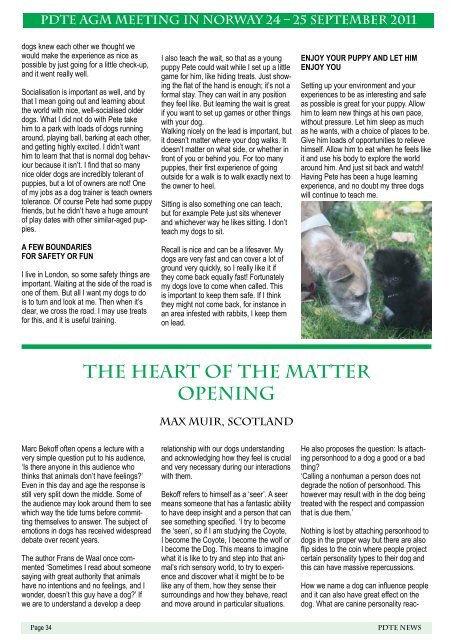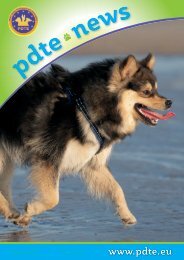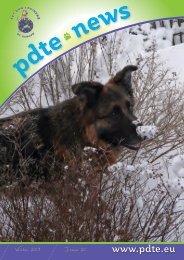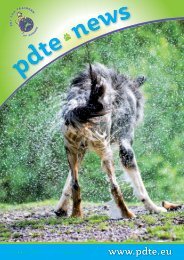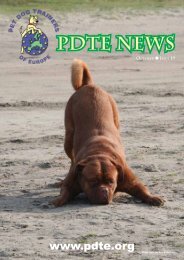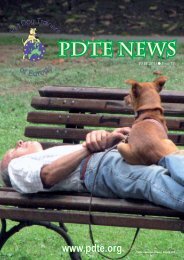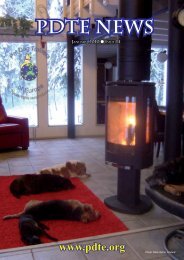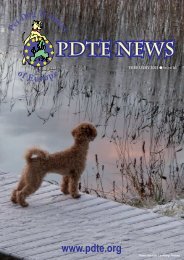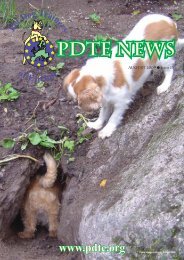PDTE 2012 March Newsletter
Create successful ePaper yourself
Turn your PDF publications into a flip-book with our unique Google optimized e-Paper software.
<strong>PDTE</strong> AGM MEETING In NORWAY 24 – 25 September 2011<br />
dogs knew each other we thought we<br />
would make the experience as nice as<br />
possible by just going for a little check-up,<br />
and it went really well.<br />
Socialisation is important as well, and by<br />
that I mean going out and learning about<br />
the world with nice, well-socialised older<br />
dogs. What I did not do with Pete take<br />
him to a park with loads of dogs running<br />
around, playing ball, barking at each other,<br />
and getting highly excited. I didn’t want<br />
him to learn that that is normal dog behaviour<br />
because it isn’t. I find that so many<br />
nice older dogs are incredibly tolerant of<br />
puppies, but a lot of owners are not! One<br />
of my jobs as a dog trainer is teach owners<br />
tolerance. Of course Pete had some puppy<br />
friends, but he didn’t have a huge amount<br />
of play dates with other similar-aged puppies.<br />
A FEW BOUNDARIES<br />
FOR SAFETY OR FUN<br />
I live in London, so some safety things are<br />
important. Waiting at the side of the road is<br />
one of them. But all I want my dogs to do<br />
is to turn and look at me. Then when it’s<br />
clear, we cross the road. I may use treats<br />
for this, and it is useful training.<br />
I also teach the wait, so that as a young<br />
puppy Pete could wait while I set up a little<br />
game for him, like hiding treats. Just showing<br />
the flat of the hand is enough; it’s not a<br />
formal stay. They can wait in any position<br />
they feel like. But learning the wait is great<br />
if you want to set up games or other things<br />
with your dog.<br />
Walking nicely on the lead is important, but<br />
it doesn’t matter where your dog walks. It<br />
doesn’t matter on what side, or whether in<br />
front of you or behind you. For too many<br />
puppies, their first experience of going<br />
outside for a walk is to walk exactly next to<br />
the owner to heel.<br />
Sitting is also something one can teach,<br />
but for example Pete just sits whenever<br />
and whichever way he likes sitting. I don’t<br />
teach my dogs to sit.<br />
Recall is nice and can be a lifesaver. My<br />
dogs are very fast and can cover a lot of<br />
ground very quickly, so I really like it if<br />
they come back equally fast! Fortunately<br />
my dogs love to come when called. This<br />
is important to keep them safe. If I think<br />
they might not come back, for instance in<br />
an area infested with rabbits, I keep them<br />
on lead.<br />
ENJOY YOUR PUPPY AND LET HIM<br />
ENJOY YOU<br />
Setting up your environment and your<br />
experiences to be as interesting and safe<br />
as possible is great for your puppy. Allow<br />
him to learn new things at his own pace,<br />
without pressure. Let him sleep as much<br />
as he wants, with a choice of places to be.<br />
Give him loads of opportunities to relieve<br />
himself. Allow him to eat when he feels like<br />
it and use his body to explore the world<br />
around him. And just sit back and watch!<br />
Having Pete has been a huge learning<br />
experience, and no doubt my three dogs<br />
will continue to teach me.<br />
THE HEART OF THE MATTER<br />
OPENING<br />
Max MUIR, Scotland<br />
Marc Bekoff often opens a lecture with a<br />
very simple question put to his audience,<br />
‘Is there anyone in this audience who<br />
thinks that animals don’t have feelings?’<br />
Even in this day and age the response is<br />
still very split down the middle. Some of<br />
the audience may look around them to see<br />
which way the tide turns before committing<br />
themselves to answer. The subject of<br />
emotions in dogs has received widespread<br />
debate over recent years.<br />
The author Frans de Waal once commented<br />
‘Sometimes I read about someone<br />
saying with great authority that animals<br />
have no intentions and no feelings, and I<br />
wonder, doesn’t this guy have a dog?’ If<br />
we are to understand a develop a deep<br />
relationship with our dogs understanding<br />
and acknowledging how they feel is crucial<br />
and very necessary during our interactions<br />
with them.<br />
Bekoff refers to himself as a ‘seer’. A seer<br />
means someone that has a fantastic ability<br />
to have deep insight and a person that can<br />
see something specified. ‘I try to become<br />
the ‘seen’, so if I am studying the Coyote,<br />
I become the Coyote, I become the wolf or<br />
I become the Dog. This means to imagine<br />
what it is like to try and step into that animal’s<br />
rich sensory world, to try to experience<br />
and discover what it might be to be<br />
like any of them, how they sense their<br />
surroundings and how they behave, react<br />
and move around in particular situations.<br />
He also proposes the question: Is attaching<br />
personhood to a dog a good or a bad<br />
thing?<br />
‘Calling a nonhuman a person does not<br />
degrade the notion of personhood. This<br />
however may result with in the dog being<br />
treated with the respect and compassion<br />
that is due them.’<br />
Nothing is lost by attaching personhood to<br />
dogs in the proper way but there are also<br />
flip sides to the coin where people project<br />
certain personality types to their dog and<br />
this can have massive repercussions.<br />
How we name a dog can influence people<br />
and it can also have great effect on the<br />
dog. What are canine personality reac-<br />
Page 34<br />
<strong>PDTE</strong> NEWS


